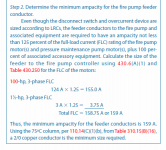JoeStillman
Senior Member
- Location
- West Chester, PA
More and more utilities are requiring cold-sequence metering, and they don't want an overcurrent device ahead of the meter. But non-fused disconnects are only good for 10 kA SCCR. It's a rare fire pump service indeed that is that soft.
- Is there a class of fuses that are for Short-Circuit only, and not Overload?
- Has anybody used cable limiters in this situation?
- Would these fuses raise the AIC rating of a fusible disconnect?

